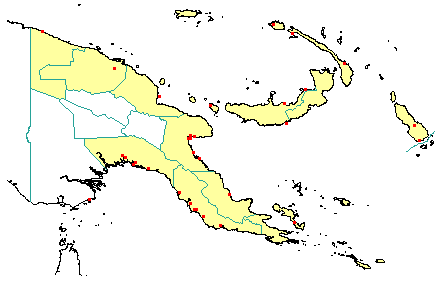
in PNGplants database
PNGTrees – Rhizophora apiculata Blume |
Barry Conn (NSW) & Kipiro Damas (LAE).
Copyright held by the authors, Royal Botanic Gardens and Domain Trust, and Papua New Guinea National Herbarium
Enumeratio Plantarum Javae 1 (1827)
Other Literature: M. Percival and J.S. Womersley, Floristics and Ecology of the Mangrove Vegetation of Papua New Guinea 81 (1975) Fig. 60.
Field Characters: Small trees 5-9 m high or large trees 10-40 m high. Bole cylindrical 18-40(-60) cm diam.; straight 10-20(-30) m long; buttresses absent; spines absent; aerial roots present; stilt roots present up to 2 m high. Bark dark brown or grey often dark, rough, sometimes tessellated slightly, slightly pustular, or irregularly fissured with deep longitudinal and horizontal fissures; lenticels irregular; subrhytidome dark green; bark thickness <25 mm thick, 10.0-25.0 mm thick; blaze consisting of one layer; faintly to non-aromatic or strongly aromatic; resinous/linament-like; outer blaze brown, orange, or red, markings absent, fibrous or granular with splinters; inner blaze orange, brown, or red, markings absent, fibrous or granular with splinters; exudate absent or present, colourless, spotty, changing colour on exposure to air, to grey or pale brown, sticky. Terminal buds not enclosed by leaves but enclosed by stipules; complex hairs absent; stinging hairs absent; mature twig without hairs.
Leaves: Clustered at end of branches <internodes indistinct>. Leaves opposite, simple; petiole present 15-30 mm long, not winged, attached to base of leaf blade <not peltate>, not swollen; lamina broadest at or near middle, (9.0-) 13.0-18.0 cm long, (4.0-) 5.0-8.0 cm wide; lamina symmetric, margin entire, not dissected or lobed, apex sub acute, obtuse, or acuminate, venation pinnate <secondary veins arising from the midrib along its length>, secondary veins open <spaced far apart to easily see tertiary veins>, not prominent, but visible, intramarginal veins absent; lower surface pale green, upper surface green or glossy dark green, hairs absent; oil dots absent; domatia absent; stipules present, joined, joined across twigs <growing between opposite leaves and leaving a scar between them when they fall; interpetiolar>, encircling the twig <amplexicaul>, leafy, not fringed, large <easily visible to the eye> 50-80 mm long, usually not persistent.
Flowers: Inflorescence axillary <from between a leaf and branch> or often on the trunk or branches <cauliflorous-ramiflorous> just below leaves. Flowers on an unbranched axis borne in pairs on stout peduncle 8-10 mm long; flowers bisexual, not stalked, with many planes of symmetry <actinomorphic>, 6.0-10.0 (-15.0) mm long, large (>10 mm diam.) 10-15 mm diam.; perianth present, with distinct sepals and petals, white, yellow, or green; inner perianth 4, free; stamens 10-12, filaments absent or present but then very short, free of each other, free of perianth; ovary partly inferior <perigenous>, carpels joined (when more than one) <syncarpous>, locules 2; styles solitary <including joined together> short, 1.
Fruits: Fruits arranged on unbranched axis. Fruit 20-25 mm long, 10.0-15.0 mm diam., fruit brown, not spiny, non-fleshy or slightly fleshy leathery, simple, indehiscent, drupe the fruit does not fall from the tree, the hypocotyl reaches a considerable length before ripening and falling. Seeds 1 (-3), about 10 mm long 10 mm long, not winged, as wide as long, 1-10 mm diam. 8-10 mm diam.
Distribution: West Sepik, Gulf, Madang, Morobe, Papuan Islands, East Sepik, Northern, Central, Bougainville, Manus, New Ireland, New Britain & Milne Bay.
 | Botanical records in PNGplants database |



 .
.